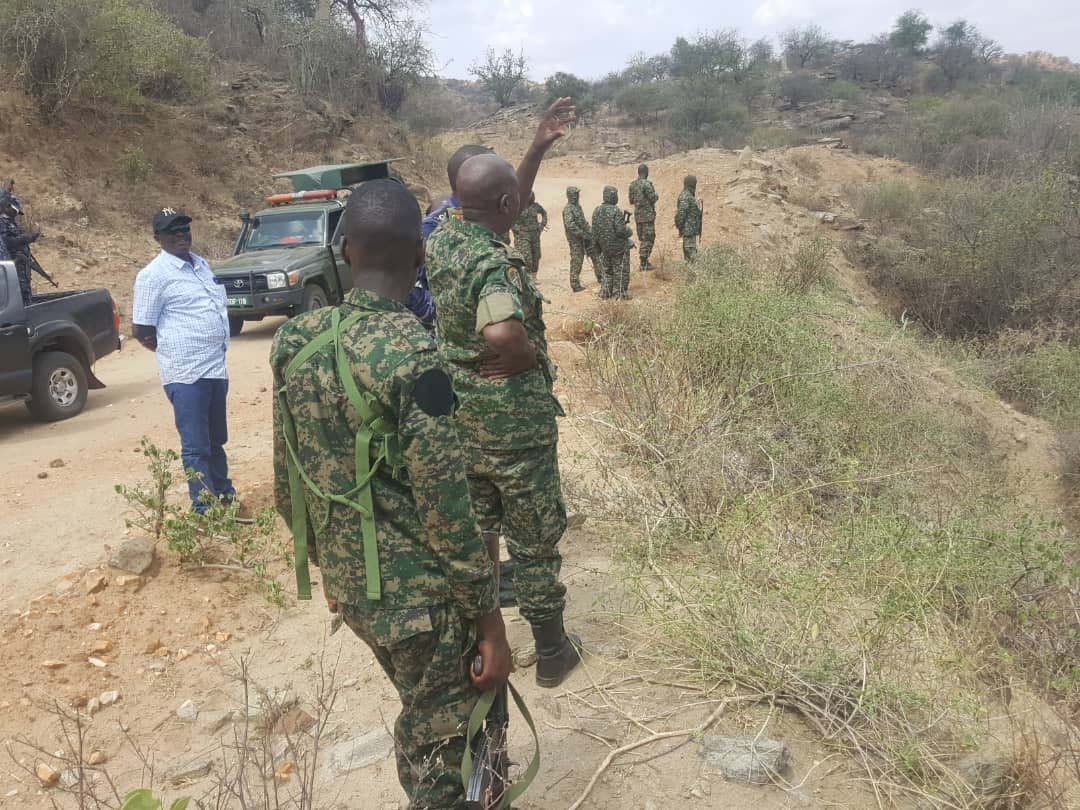Prime
Is there a link between insecurity and mineral wealth in Karamoja?

UPDF soldiers show a grazing area in Moroto previously occupied by Turkana pastoralists.
What you need to know:
- In March 2021, government commenced an airborne geological and geo-physical survey mapping of Karamoja at a cost of Shs86b. With large swathes under the threat of violence and rustling, it is not clear yet when the assignment will be accomplished.
Mr Emmanuel Lupoyeko, the Loyoro Sub-county chief, argues: “When you grab land without the consent of the people, you are also causing insecurity.”
Mr Lupoyeko says his community have learnt lessons from the mistakes of locals in Rupa Sub-county.
“If these investors come in a tricky way, they will not take our land. Here we are telling them that if you come you can exploit but all the benefits should remain here even the factory, the community should benefit.”
Mr Achia says “perhaps people are taking advantage of insecurity to be able to acquire land and dissuade people from going into those lands.”
However, the lawmaker plays down this fear.
“I know that there are lot of theories, but I am one of the persons who is reluctant to take that notion that the current conflict rotates around the natural resources, it is true we have a lot of natural resources in Karamoja, we have a lot of concessions held by individuals, and there are certain areas you can’t even reach, you cant even graze. One of these [areas] is the sunbelt in Rupa where you can’t access the area unless you are cleared, we have the oil deposits in Napak District,” he says.
“There is a lot of insecurity and insecurity is more related to livestock. It is about that mismanagement. The discourse about minerals can actually come later but we should be interested in protecting life,” he adds.
In March 2021, government commenced an airborne geological and geo-physical survey mapping of Karamoja at a cost of Shs86b. With large swathes under the threat of violence and rustling, it is not clear yet when the assignment will be accomplished.
A 2011 survey found that the region contains more than 50 minerals, including gold, limestone, uranium, marble, graphite, gypsum, iron, wolfram, nickel, copper, cobalt, lithium, and tin.
However, for every tonne of mineral that leaves the area in large trucks, critics say the equivalent is a life of misery and ruin.
For every mineral licence doled out to investors, including briefcase companies, droves of children escape this wretched part of the country for the city where they line the streets with their begging bowls.
Karamoja is not entirely neglected. Newly paved highways have been constructed to connect some of the districts. But it leaves much to be desired.
Many of Karamoja’s sprawling mines appear like labour camps where locals spend days hacking at the earth tucked away beneath the rugged landscape. Scores of men, women and children dig inside the bowels of the mines without any protective gear inhaling toxic fumes.
Those who work here are largely illiterates and don’t know much about the scramble for mineral wealth worth billions of shillings led by multinational corporation capital.
Mr Massa of Resource Rights Africa refers to the problem in Karamoja as an elite capture.
He says the elite in Karamoja who negotiate mineral concession deals have benefited at the expense of the illiterates in the community.
Many remain enveloped in poverty as the minerals are carted off towards Kampala and others are shipped outside the country.
Nobody knows how much of this mineral wealth leaves this poorest part of the country.
Many parts of Karamoja appear like wastelands as the environment continues to be ravaged as this creates more food insecurity.
Water sources are contaminated as a result of mining activities and gaping pits have turned into death traps.
“We need to fill the pit holes, ensure that they plant the trees, ensuring that they use the resources sustainably, these minerals will be exhausted, then what happens later?” argues Mr Massa.
This is the pent-up frustration that has elicited strong condemnation from leaders in Karamoja, including the former Ethics minister, the late Rev Fr Simon Lokodo, who implored government to appoint a commission of inquiry into the mining activities.
Fr Lokodo seemed to have fired a veiled salvo at the Chinese-owned Sunbelt company, which sits on 3.3 square km of land and has been mining marble in Rupa Sub-county.
The company later expanded its operations to cover an additional 4.1 square kilometres, pushing more families out of their ancestral homes.
The company, whose activities are quite opaque, enjoys protection from the army, which has established a roadblock towards the mining site.
Daily Monitor was able to estimate that about 3. 7 million acres has been parcelled out for these mining activities. An acre is equivalent to the size of a football pitch.
The proportion of Karimojong trapped in chronic poverty is at 24 percent, twice higher more the national average of 10 percent, according to the Uganda National Household Survey 2016/17.
The overall literacy rate for Karamoja stands at only 25 percent, compared to 94 percent in Kampala, while 60 percent of women in the sub-region are unable to read and write. Eighty six percent of the young population in Karamoja have never been to school.
Like the DR Congo paradox of plenty, Karamoja is perhaps the richest part of the country in terms of mineral wealth, yet its people remain locked in abject poverty.
READ MORE




